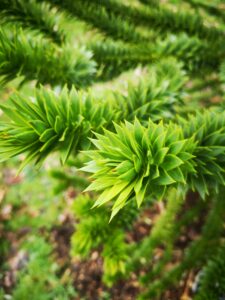What determines the lifespan of a tree leaf?
It’s a simple question, but until now, did not have a simple answer. Whilst some trees grow for hundreds, if not thousands of years, the leaves on different species of tree live anywhere from a few months to 20 years or more. The leaves on a blueberry bush live only a few months, the maple tree leaves live for a season before falling and leaves of a monkey puzzle tree can live for two decades.


Left: Leaves of a monkey puzzle tree, Araucaria Araucana, Westonbirt Arboretum, UK. ©Natalie Sanders. Right: Leaves on a Japanese maple tree ©Flicker
What is it that decides how long the leaves should live? It turns out, it is all to do with economics.
A new paper entitled: “Leaf economics fundamentals explained by optimality principles” was just published in Science Advances. This work represents a theoretical breakthrough by LEMONTREE’s Dr Wang Han and Prof Iain Colin Prentice and other researchers from Japan, Norway, USA, and Australia.
The leaf economics spectrum was first described almost 20 years by co-authors Prof Iain Wright and Prof Mark Westoby (Macquarie University) in the paper “The world-wide leaf economics spectrum” in Nature.
The LES described the observed relationships between different leaf traits and demonstrated that plants with thicker and/or denser leaves (greater leaf mass per unit area [LMA]) have longer life spans. We know that evergreen and deciduous trees behave differently along latitudinal gradients. Evergreen trees have longer-living leaves the closer they are to the poles and that deciduous trees do the opposite. Deciduous trees tend to have their longest living leaves the closer to the tropics they are. But we didn’t really know why, until now.
In our Science Advances paper, we show that this empirical generalization (the foundation of the worldwide leaf economics spectrum) is a consequence of natural selection, maximizing average net carbon gain over the leaf life cycle.
We knew that long-lived leaves tend to be tougher and thicker, and more expensive to build. Now, we have identified the major environmental factors at play, and summarised them in two equations.

Relationship between leaf life (LL) and leaf mass per unit areas in (1) evergreens and (2) deciduous plants.
We tested our equations using data from thousands of species from hundreds of ecosystems, drawn from the China Plant Trait Database and the Global Plant Trait Network. Analysing these two large leaf trait datasets, we show that evergreen and deciduous species with diverse construction costs (assumed proportional to LMA) are selected by light, temperature, and growing-season length in different, but predictable, ways. We quantitatively explain the observed divergent latitudinal trends in evergreen and deciduous LMA and show how local distributions of LMA arise by selection under different environmental conditions acting on the species pool. These results illustrate how optimality principles can underpin a new theory for plant geography and terrestrial carbon dynamics.
“Evergreen conifers growing in poor soil in areas with a long cold winter can only thrive if they make long-term investments in their leaves. Whereas deciduous trees, like the maple, race to create new leaves and capture carbon in the summer sun before leaf-drop in autumn. The economically rational decision for a maple tree is to invest in fast-growing, cheap but flimsy leaves.” says co-author Professor Ian Wright from Macquarie University and Western Sydney University.
We now have a quantitative theory that explains the leaf economics spectrum, data analyses that support the theory’s key predictions; and for good measure, an explanation of the diverging latitudinal trends of leaf properties between evergreen and deciduous species of trees that almost perfectly fits the data. These leaf economic traits are fundamental to the carbon cycle and nutrient economy.
It’s taken some time to get here, but one key realization was that we can predict the optimum value of both leaf mass-per-area and leaf lifetime (as opposed to the relationship between them) by starting with independent “prior” distributions of both properties, which are given to us by nature – and assume that natural selection does the rest.
We live in a changing environment and all plants are subjected to selective pressures that can modify the economic efficiency of their plant traits. This research will not only explain what grows where today, but it will also move ecology into a predictive science that will:
- enable better, more accurate global and regional climate models
- allow land managers to better model forests and other vegetation, and predict how climate change will affect ecosystems
- allow better estimation of crop yield and the impact of climate change on agriculture.
We’re working towards a comprehensive theory for plant functional traits and how they are selected for by the environment. This paper provides a key element. The theory will underpin a new generation of land ecosystem models that will rest on firmer theoretical and empirical foundations than those in use today.
This work was part-funded by LEMONTREE (Land Ecosystem Models based On New Theory, obseRvations and ExperimEnts) project, funded through the generosity of Eric and Wendy Schmidt by recommendation of the Schmidt Futures program. This research was also supported by Colin’s European Research Council (ERC) under the European Union’s Horizon 2020 research and innovation programme (Grant No: 787203 REALM).
You can read the full paper here:
Wang, H., Prentice, I.C., Wright, I.J., Warton, D.I., Qiao, S., Xu, X., Zhou, J, Kikuzawa, K., Stenseth, N.C. 2023. Leaf economics fundamentals explained by optimality principles. Science Advances, 9(3), DOI: 10.1126/sciadv.add5667

